Project
Justice: Rival Schools 2
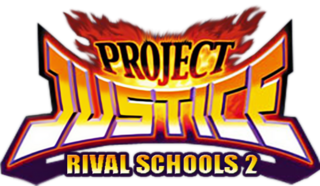 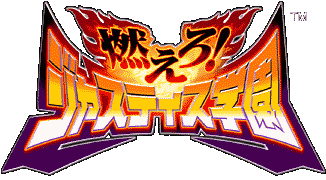
STORY:
One year has passed since the events of United by Fate and that things have gone back to normal in Aoharu City. Batsu Ichimonji, Hinata Wakaba, Kyosuke Kagami, and the rest of the fighters had resumed their normal school lives and that all of them had enjoyed the calm peace that came after
their last adventure, but the peace itself doesn't last for long and that the fighters would soon find themselves getting involved in a new struggle.
Kurow Kirishima: a cold-hearted and ruthless ninja assassin from a mysterious group known only as the "Reverse Society" has his sight set on the Imawano family and plans to eliminate them and their allies so that he can prepare for the advancement of his own ambition to rule Japan. To this end, he
attacks Raizo Imawano: the principal of Justice High and father to Batsu, so that he can easily put him out of commission and not have any interference come from him.
Secondly, he sends both his older sister Yurika Kirishima and his loyal subordinate Momo Karuizawa into the ranks of the fighters so that the two of them can cause tension and distrust to occur
between the friends. His third plot involves brainwashing Gedo gang leader Daigo Kazama so that he can order him into forcing his gang to attack various schools in order to cause even more tension to occur. Lastly, Kurow himself plans to destroy Batsu's reputation by disguising himself as Batsu's doppelganger (named Vatsu) so that he can attack the fighters
and make them believe that Batsu is behind it. Batsu and his friends must fight back against the evil plot of Kurow and attempt to not let their friendship get destroyed by the conspiracy of a deadly ninja assassin.
|
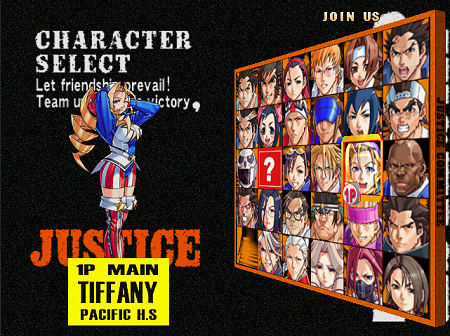
|
|
"Back to school" is actually
a good thing... for once.
|
REVIEW:
The sequel to
Rival Schools: United by Fate... known as Project Justice: Rival Schools 2
in Japan & Europe, and simply Project Justice in America. The name "Rival Schools" was censored for the American version due to the Columbine shooting incident, which occurred close to the game's release. According to sources, the name "Rival Schools" potentially may have upset some folks during that time
period, thus, the name of the game was changed in America to Project Justice.
Project Justice: Rival Schools 2 brings back the entire roster from the first game (with the exception of Raizo), and introduces 10 exciting new characters to the
series (including several "alternate" versions of classic characters).
The new characters present awesomely insane new
fighting styles, colorful personalities, and of course, wild super moves! Whether it's fighting with tennis rackets,
violins, baseball bats, and/or kendo sticks... Project Justice has you covered. This game definitely brings the variety and creativity in terms of character designs, offering something very different from the norm of what you'd expect from fighting games! The loveable "high school stereotypes" in Project Justice are more than
they appear at first, and are for sure one coolest and most well-rounded fighting game rosters in history!
|
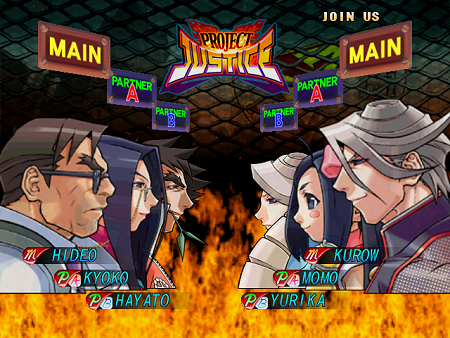
|
|
Some of the best
2D fighting game artwork of ALL TIME.
|
Like its predecessor, Project Justice
is one of the few fighting games with an engaging storyline within the
game. Story Mode gets you acquainted with the characters and their agenda, and is presented exceptionally well with beautifully-drawn artwork by Capcom's Edayan and well-written dialogue. Story-telling brought to life with an awesome soundtrack, with some excellent tracks exclusive to Story Mode. While the entire story mode isn't voiced, the Japanese
character voice-overs within the game are brilliantly done and are filled with emotion, hilarity, and drama! In addition to Story, Free Mode allows you to choose any 3 characters and play through the arcade mode of the game (mirroring the arcade version).
Simply put... Project Justice is a work of art, before you even start playing the game. Edayan added so much to Project
Justice, filling every character with life and tons of personality. The in-game character models
mirror Edayan's artwork rather nicely, as well. For the record, the artwork of Rival Schools is easily my personal favorite art-style
of any fighting game!
|
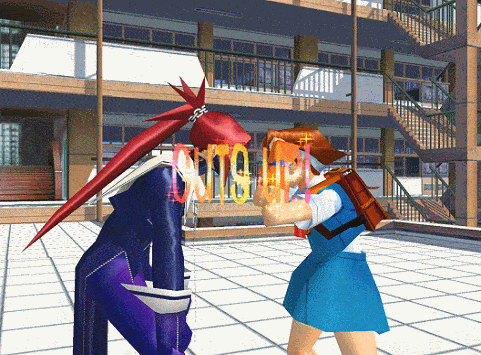
|
|
GUTS UP! Some super moves restore health to your
partner.
|
The core gameplay is very similar to the first Rival Schools, but with a few differences. To start, the Vigor Meter is now has a max of 5
levels (down from 9 in the previous game). Like in the original Rival Schools, characters can use Quick Sidesteps at
any time to dodge projectiles and other attacks! "Perfect Sidesteps" happen automatically (by timing your sidestep precisely as your opponent attacks when in close) resulting in a 180 maneuver putting your character directly behind
the attacking opponent (now faster than in the prequel).
Dodging projectiles and linear attacks with a properly-timed sidestep can put you in position to hit a combo or K.O. your opponent with a devastating super move. Air combos also return and are comparable to the likes of Marvel VS Capcom
in terms of height and pure epicness. After a launcher, a staple air combo consists of around 4 normal hits, which you can cancel into a special or a super move. In general, longer air-combos are possible than in the prequel. It's a fun combo system, for sure! another imperative mechanic to learn: Tardy Counters create an opening during an opponent's attack, which can grant you a combo if timed and spaced correctly (and cost 1 meter).
|
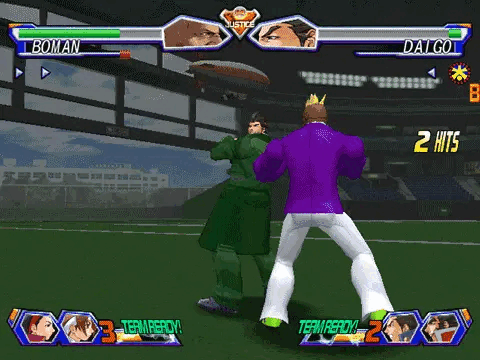
|
|
Strike
a cool pose. . . get wrecked.
|
Project Justice adds one more fighter per team (over the first game), making for awesome
three-on-three team battles (King of Fighters style). Players can still switch out
their main character with one of their partner characters after each round ends, which adds somewhat of a "card game" strategy element if you study the best match-ups. The hard-hitting Double Team super moves are back,
and now with a third partner, a Triple Team "Party-Up" Attacks can be performed (which use all 5 meters of the Super Combo Gauge)! Crazy!!!  The Triple Team Attacks range from being completely ridiculous and silly
looking to downright badass... but like most attacks in this game, never fail to add to the incredible ouch factor!
The Triple Team Attacks range from being completely ridiculous and silly
looking to downright badass... but like most attacks in this game, never fail to add to the incredible ouch factor!
Another new mechanic called "Team-up" allows players who are hit by a Team Attack to quickly "interrupt" the opponent (costing 1 meter) and potentially escape from the Super Combo without taking further damage (performed by pressed the same input as a Team Combo). During this sequence, 1 character from each team (not currently in battle) enter a quick
"1-hit-kill" deathmatch scenario. If the defending player can score an attack before 5 seconds runs out, they'll break out of the Team Attack. This interesting mechanic is definitely an innovative and fun element of Project Justice's gameplay, and is very unique to fighting games!
|
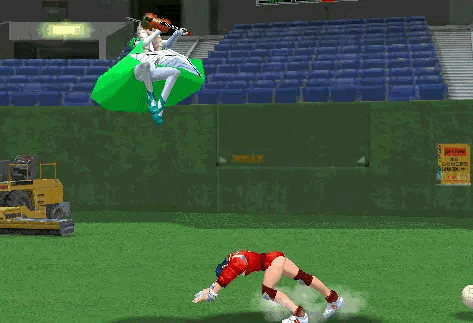
|
|
A
solid air-combo system offering plenty of fun.
|
Project Justice's animation is charismatic and full of excitement! The stylized and exaggerated movements of each character truly define them. Many characters have completely unique walking animations (such as Momo, Tiffany, and Kyoko) which are easily some of the smoothest and coolest walk animations in fighting game
history! Characters have generally small movesets, but also have some hidden command normals, launchers, throws, and back throws, in addition to their core special
moves and super moves. Attacks hit hard and throw techniques are smooth and satisfying as well. Worth mentioning, most characters have completely original animations and moves... and don't copy many techniques from one another (which we see often in many other fighting games). Most importantly, the super moves and Tag Team Attacks definitely bring the ouch factor. The way characters hit the ground is also very satisfying.
Visually, Project Justice is a great-looking 3D fighter. The Dreamcast version isn't quite as sharp as the Naomi arcade version, but still looks great. Returning
characters stylistically appear in 3D like they're drawn in
2D-form, although certain characters still look "blocky" in some areas.
However, the cool anime-style facial detail and expressions (in-game) don't go
unnoticed. The 3D stages of Project Justice are similar to those of the Tekken
series, warping around the fighters as they battle. The "center
square," apparent in many past 3D fighting games, is very
visible in this game, oddly dividing the flat floor texture and the
background. If you want to nitpick, go ahead, but there are way better things to
look at other than the ground.  All in all, the stages do their jobs as stages, offering
variety as well as some outrageously good BGMs.
All in all, the stages do their jobs as stages, offering
variety as well as some outrageously good BGMs.
|
|

| Page Updated: |
April
20th, 2025
|
| Developer(s): |
Capcom |
| Publisher(s): |
Capcom |
| Designer(s): |
Hideaki
Itsuno
|
| Artwork
by: |
Edayan, Sinsuke Komaki, Togacchi, Harumaru, Yama
|
| Platform(s): |
Arcade,
Dreamcast
|
| Release Date(s): |
Dec.
17th, 2000

April 13th, 2001

May 16th, 2001 
|
| Characters: |
Batsu Ichimonji,
Hinata Wakaba,
Kyosuke Kagami,
Shoma Sawamura,
Natsu Ayuhara,
Roberto Miura,
Edge,
Gan Isurugi,
Daigo Kazama,
Akira Kazama,
Yurika Kirishima,
Zaki,
Hideo Shimazu,
Hayato Nekketsu,
Kyoko Minazuki,
Boman Delgado,
Tiffany Lords,
Roy Bromwell,
Incho / Chairperson,
Ran Hibiki,
Momo Karuizawa,
Nagare Namikawa, Burning
Batsu, Powered Akira, Wild
Daigo, Kurow Kirishima, Vatsu,
Hyo, Demon
Hyo, Wild Daigo |
|
|
|
Featured Video:
|
|
|
| Related Games: |
Rival Schools: United By Fate,
Capcom Fighting All Stars, Capcom
Fighting Collection 2, Street
Fighter Alpha 3, SFA3: Max, Marvel Vs.
Capcom,
Marvel Vs. Capcom 2, Capcom Vs.
SNK: Pro, Capcom Vs. SNK 2, Namco
X Capcom,
Power Stone,
Power Stone 2, Kenichi,
Warzard, Garou: Mark of the
Wolves, The King of Fighters 2000, The
King of Fighters 2001 |
|

|
|
Gameplay Engine
|
8.5 / 10
|
|
Story / Theme
|
10 / 10
|
|
Overall Graphics
|
8.0 / 10
|
|
Animation
|
8.5 / 10
|
|
Music / Sound
Effects
|
9.5 / 10
|
|
Innovation
|
8.5 / 10
|
|
Art Direction
|
10 / 10
|
|
Customization
|
8.0 / 10
|
|
Options / Extras
|
7.5 / 10
|
|
Intro / Presentation
|
9.0 / 10
|
|
Replayability /
Fun
|
8.5 / 10
|
|
"Ouch" Factor
|
9.0 / 10
|
|
Characters
|
9.5 / 10
|
|
BOTTOM LINE
|
8.9 /
10
|
|
Review based on Dreamcast
version
|
|
| Final
Words: |
With over 20 charismatic fighters... epic 3-on-3 team battles... and outrageously epic super moves and combos... there's quite a lot of fun to be had in
Project Justice. This game is heavy on charm, humor, and everything else that makes fighting games truly great. Is it underrated and underappreciated? Yes. The gameplay could be deeper and more refined, but still holds up as innovative, interesting, fast, and seriously fun.
The 3-vs-3 team setup makes Project Justice, in a way, feel like Capcom's rendition of SNK's King of Fighters. However,
Project
Justice stands on its own in so many ways. Plus, it's a 3D fighting game. The 2D standard rules still apply (and are the core of the game), but the sidestep mechanic brings the game into the third dimension. If you're not side-stepping in Project Justice, you never actually learned how to play (same with Tekken).  In all honestly, one of my favorite aspects of the gameplay is the raw sidestep (to dodge projectiles) and the perfectly-timed 180 sidestep allowing you to get behind your opponent for an attack! Seriously fun when you're not hitting 20-hit air combos and YOLO super moves. Ohh yes, it's fun. In all honestly, one of my favorite aspects of the gameplay is the raw sidestep (to dodge projectiles) and the perfectly-timed 180 sidestep allowing you to get behind your opponent for an attack! Seriously fun when you're not hitting 20-hit air combos and YOLO super moves. Ohh yes, it's fun.
The gameplay has its janky moments, and some movements lack the fluidity and polish of modern Street Fighter or Tekken games of the era, but overall, Project Justice: Rival Schools 2 feels smoother than it looks. Feels. The flashy air-combos, stylish super moves, and insane team-attacks make Project Justice a unique and fun game to watch and play. A hidden gem on
Dreamcast, you'd be missing out on one of Capcom's most interesting fighting
games if you passed on this one.
I repeat... it's very cool to see a 3D fighting game from Capcom, which in retrospect, became a crazy rare thing. The animations, the crazy air-combos, the innovative ideas... Project Justice was very ahead of its time and seemed like it was going places. I'll lead to believe the next successor was actually the canceled
Capcom Fighting All-Stars.
The presentation and heart put into Project Justice is rivaled by few other fighting games. Team Capcom 2000 put incredible effort into this game. A flawless, brilliant, and beautiful art style (by Edayan), an incredibly catchy and well-designed soundtrack, lovable characters, and an entertaining story mode. From every angle, Project Justice
is a simply superb fighting game and a must-play / must-own.
~TFG
Webmaster | @Fighters_Gen
|
|
|
|
|
|
|
|
|
|
|